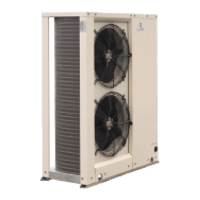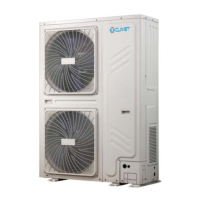Do you have a question about the CLIVET MSAT-XEE 12.2 and is the answer not in the manual?
Details potential risks and emphasizes the need for qualified personnel for installation and maintenance.
Covers considerations for positioning, hydraulics, electrics, and ducting as per regulations.
Advises on planning periodic inspection and maintenance to reduce costs.
Instructs immediate deactivation and contacting a service agent for breakdowns.
Lists key areas for user training by the installer, including operation and maintenance.
Provides a step-by-step guide for safely handling and lifting the unit.
Details unit placement criteria, including external fixed positions and vibration transmission.
Warns about refrigerant traps and the risk of explosion due to temperature increases.
Provides steps for checking refrigerant leaks using nitrogen pressurization.
Outlines procedures for creating a vacuum in the system.
Details the process of charging the system with refrigerant gas.
Lists steps for making electrical connections, including safety checks.
Details the electrical connections to be made by the customer, with a wiring diagram.
Emphasizes that start-up should be done by qualified technicians and outlines preliminary checks.
Lists essential checks before unit power supply, covering safety, functional spaces, and connections.
Details the steps for the unit's start-up sequence after power supply is on.
Explains how to check and correct compressor rotation direction to avoid damage.
Covers checks for grounding, conductor tightening, voltage, and phase balance.
Advises on the importance and timing of compressor crankcase heater operation.
Details the procedure for turning the unit ON/OFF, including emergency stop.
Details the procedure for resetting alarms after the cause has been removed.
Emphasizes that maintenance must be done by authorized centers and its benefits.
Identifies common situations that could be sources of risk.
Defines the danger zone accessible only to authorized operators.
Warns about risks during handling if proper precautions are not taken.
Lists risks associated with incorrect installation, including leaks and electrical hazards.
Covers risks like burning smells, accidental contact with components, and panel security.
Details risks related to electrical connections, component covers, and earthing.
Warns about injuries from contact with transmissions or fans.
Discusses risks from safety valve expulsion and contact with refrigerants.
Lists alarm codes and their descriptions.
Details potential risks and emphasizes the need for qualified personnel for installation and maintenance.
Covers considerations for positioning, hydraulics, electrics, and ducting as per regulations.
Advises on planning periodic inspection and maintenance to reduce costs.
Instructs immediate deactivation and contacting a service agent for breakdowns.
Lists key areas for user training by the installer, including operation and maintenance.
Provides a step-by-step guide for safely handling and lifting the unit.
Details unit placement criteria, including external fixed positions and vibration transmission.
Warns about refrigerant traps and the risk of explosion due to temperature increases.
Provides steps for checking refrigerant leaks using nitrogen pressurization.
Outlines procedures for creating a vacuum in the system.
Details the process of charging the system with refrigerant gas.
Lists steps for making electrical connections, including safety checks.
Details the electrical connections to be made by the customer, with a wiring diagram.
Emphasizes that start-up should be done by qualified technicians and outlines preliminary checks.
Lists essential checks before unit power supply, covering safety, functional spaces, and connections.
Details the steps for the unit's start-up sequence after power supply is on.
Explains how to check and correct compressor rotation direction to avoid damage.
Covers checks for grounding, conductor tightening, voltage, and phase balance.
Advises on the importance and timing of compressor crankcase heater operation.
Details the procedure for turning the unit ON/OFF, including emergency stop.
Details the procedure for resetting alarms after the cause has been removed.
Emphasizes that maintenance must be done by authorized centers and its benefits.
Identifies common situations that could be sources of risk.
Defines the danger zone accessible only to authorized operators.
Warns about risks during handling if proper precautions are not taken.
Lists risks associated with incorrect installation, including leaks and electrical hazards.
Covers risks like burning smells, accidental contact with components, and panel security.
Details risks related to electrical connections, component covers, and earthing.
Warns about injuries from contact with transmissions or fans.
Discusses risks from safety valve expulsion and contact with refrigerants.
Lists alarm codes and their descriptions.
| Model | MSAT-XEE 12.2 |
|---|---|
| Category | Heat Pump |
| Cooling Capacity | 12.2 kW |
| Heating Capacity | 13.5 kW |
| Power Supply | 400V / 3Ph / 50Hz |
| Refrigerant | R410A |
| Sound Power Level | 62 dB(A) |











